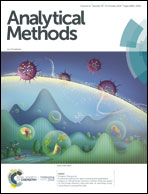Equivalency calculation of unknown enzyme inhibitors in situ the adsorbent of effect-directed autograms
Abstract
Reliable biochemical quantification of the enzymatically produced signals of enzyme inhibitors has recently been achieved in situ an assay-containing chromatographic bed, i.e. the adsorbent of an effect-directed autogram. As most of the enzyme inhibitors discovered in a complex sample are unknown or unidentified, external standard calibration cannot be performed, and their inhibition potency needs to be estimated by alternative means. Thus, herein, two different modes of equivalency calculation, referring to a potent inhibitor that was either applied or developed, were investigated, validated and compared, exemplarily for acetyl- and butyrylcholinesterase (AChE/BChE) inhibition zones in the Peganum harmala (P. h.) seed extract. Moreover, three potent inhibitors, i.e. physostigmine (PHY), rivastigmine and piperine, were considered for equivalency calculation. With regard to their hRF value, band shape and inhibition brightness against the plate background, the properties of PHY were most similar to those of the unidentified inhibitors in the P. h. seed extract, and thus, it was selected as a reference. The HPTLC-AChE assay with 1-naphthyl acetate as a substrate and Fast Blue B salt as a chromogenic reagent was suitable to reveal the potential differences between the two modes of equivalency calculation due to its low limits of detection. Quantification was studied via PHY zones that were applied versus developed on a high-performance thin-layer chromatography (HPTLC) plate. Both intraday precision and reproducibility showed the same trend, i.e. the equivalency calculation via the developed PHY bands was more repeatable than that via the applied PHY bands. The steeper slope of the calibration curve of the developed PHY bands offered a more sensitive quantification. The resulting equivalent inhibition of the ChE inhibitors in 1 μg per band of P. h. seed extract showed a bias of ca. 30% when calculated via the applied versus developed PHY bands, whereby the total AChE-to-BChE inhibition ratio (ca. 2.4) of the ChE inhibitors in 1 μg per band of P. h. seed extract remained almost the same. As a result, the enzyme inhibition equivalency calculated via the developed reference bands was more reliable and sensitive than that calculated via the applied reference bands. When a faster procedure (applied band pattern) is selected for routine equivalency calculation as a compromise, a potential bias has to be taken into account.



 Please wait while we load your content...
Please wait while we load your content...